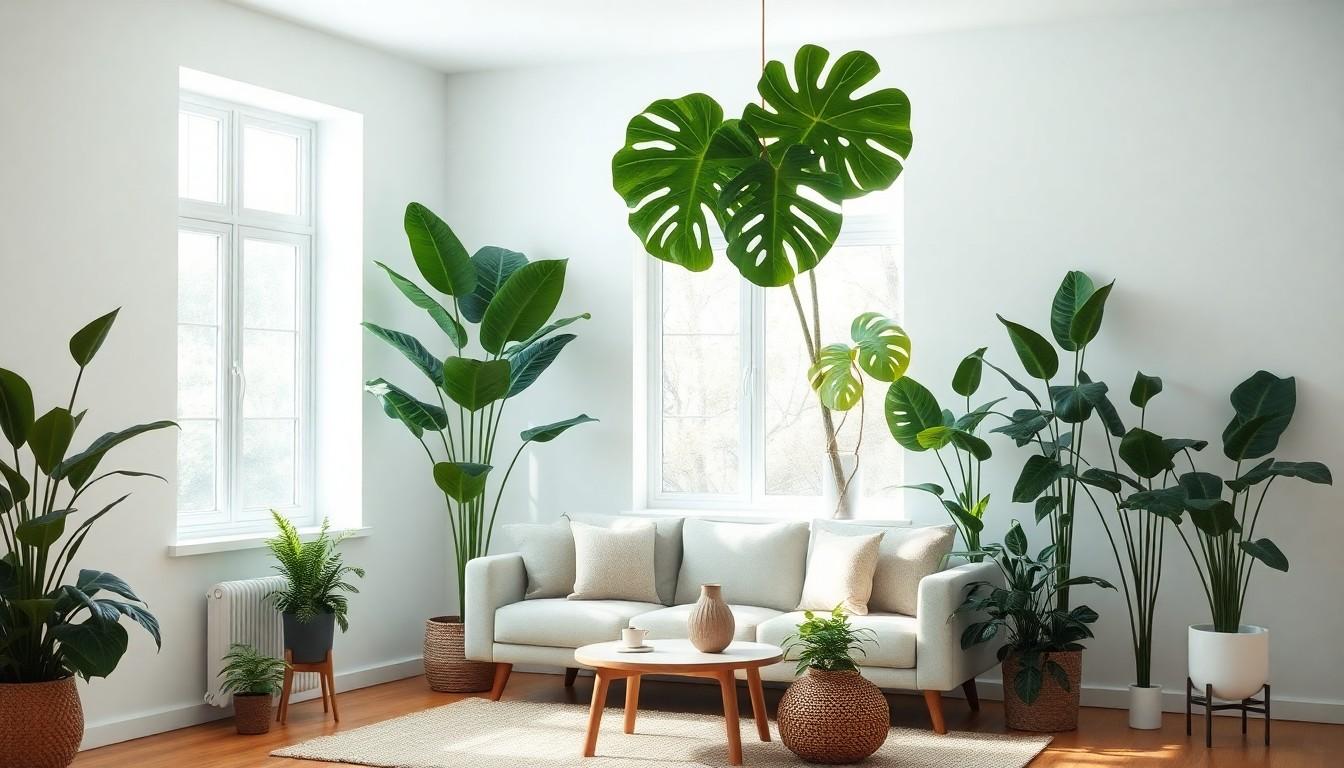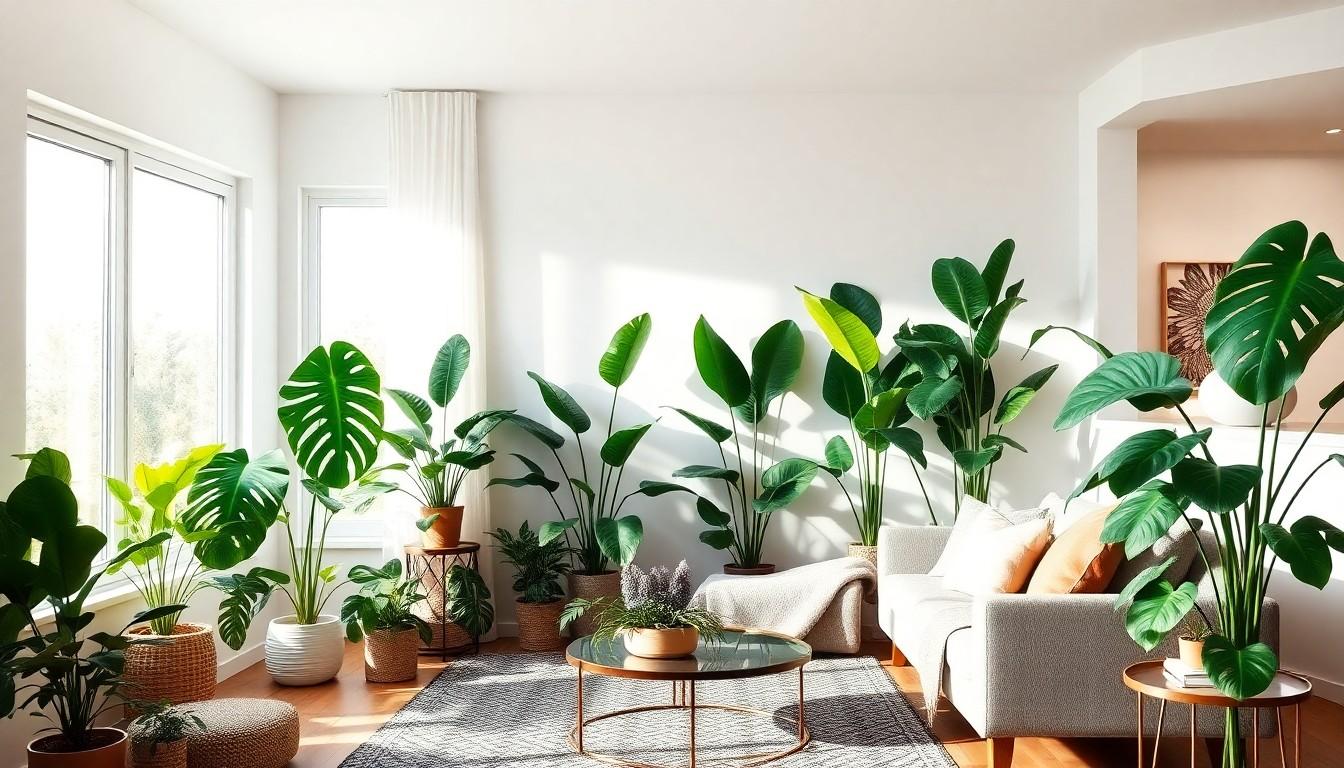Bringing the outdoors inside has never been more stylish, and large indoor house plants are leading the charge. Imagine transforming your living room into a lush oasis that even Mother Nature would envy. These green giants not only elevate your space but also boost your mood and purify the air. Who knew that having a giant leafy friend could be the secret to a happier home?
But let’s be real: large house plants can be intimidating. They might seem like they require a PhD in botany to care for, but fear not! With a little love and the right tips, anyone can master the art of indoor gardening. So, whether you’re a seasoned plant parent or just starting out, it’s time to embrace the beauty of big plants and make your home feel like a tropical getaway.
Benefits Of Large Indoor House Plants
Large indoor house plants provide numerous advantages that enhance living environments. Their presence positively influences both health and aesthetics.
Improved Air Quality
Large indoor plants significantly improve air quality by filtering toxins. They absorb pollutants such as formaldehyde and benzene, which are common in household items. Oxygen production increases as these plants photosynthesize, leading to fresher air. Furthermore, the humidity levels rise through transpiration, promoting a healthier atmosphere. Studies indicate that plants can reduce indoor air pollution by up to 87% within 24 hours. Incorporating large plants like the rubber tree or peace lily boosts both wellness and comfort.
Aesthetic Appeal
Large indoor house plants serve as striking decorative elements that enhance interiors. They create a focal point in any room, transforming spaces with their impressive sizes and vibrant greenery. Using plants like the fiddle leaf fig or monstera adds life and sophistication to modern decor. These plants integrate seamlessly with various design styles, from minimalist to bohemian. Studies reveal that greenery in living areas reduces stress and increases relaxation. With the right plant placement, large house plants contribute to a welcoming ambiance, enriching home aesthetics effectively.
Types Of Large Indoor House Plants

Large indoor house plants come in various types, each offering unique benefits and aesthetics. Understanding the differences helps in choosing the best fit for any indoor space.
Popular Varieties
Fiddle Leaf Fig (Ficus lyrata) boasts broad, glossy leaves that create a dramatic effect. Rubber Plant (Ficus elastica) thrives in bright light and offers deep green foliage. Monstera Deliciosa showcases its signature split leaves, bringing a tropical vibe indoors. Snake Plant (Sansevieria) features tall, upright leaves that are easy to care for. Dracaena marginata provides a spiky silhouette with its slender stems and strappy leaves, making it a versatile choice.
Unique Options
Bird of Paradise (Strelitzia reginae) adds exotic flair with its large, banana-like leaves. Chinese Money Plant (Pilea peperomioides) brings charm with round leaves that promote positive energy in living spaces. ZZ Plant (Zamioculcas zamiifolia) tolerates low light and drought, ideal for busy individuals. Kentia Palm (Howea forsteriana) offers a graceful, tropical appearance perfect for larger rooms. Lastly, Fishtail Palm (Caryota mitis) features feathery fronds that stand out and enhance any indoor garden.
Care Tips For Large Indoor House Plants
Caring for large indoor house plants requires attention to detail. Key factors include light, watering, and general maintenance.
Light Requirements
Light exposure directly affects the growth and health of large indoor plants. Most thrive in bright, indirect sunlight. Placing plants near east or west-facing windows offers optimal conditions. Some varieties, like the Snake Plant, tolerate low light. Conversely, Fiddle Leaf Figs demand bright light to flourish. Rotating plants every few weeks ensures even growth and prevents leaning towards the light source.
Watering Guidelines
Watering practices play a crucial role in plant health. Large indoor plants generally prefer deep watering. Checking the top inch of soil before watering is essential. If it’s dry, water until it drains from the bottom of the pot. Overwatering can lead to root rot, so monitoring soil moisture is key. Adjusting the watering schedule according to the season supports ongoing vitality. In winter, many plants need less water due to reduced growth.
Common Issues And Solutions
Large indoor house plants may face several challenges. Identifying these issues quickly leads to effective solutions.
Pests And Diseases
Spider mites, aphids, and mealybugs frequently affect indoor plants. Regular inspections help catch pests early, promoting better treatment outcomes. Neem oil serves as an effective natural pesticide, ensuring pests are eliminated without harming the plants. Fungal infections like powdery mildew can emerge in overly humid environments. Proper air circulation and avoiding overhead watering prevent such diseases. Healthy plants typically resist pests better, so maintaining optimal care and nutrition reduces vulnerabilities.
Environmental Challenges
Inadequate light often hampers the growth of large indoor plants. Positioning them near bright, indirect sunlight promotes vitality. Additionally, cold drafts can stress plants, leading to wilting or leaf drop. Maintaining a stable temperature and avoiding chilly windows protects their health. Another concern involves humidity levels; many large plants prefer higher humidity. Placing a humidifier nearby or grouping plants together creates a microclimate, enhancing their environment. Adapting solutions to these challenges ensures thriving indoor house plants.
Conclusion
Large indoor house plants bring a unique charm and vitality to any living space. Their ability to improve air quality and enhance mood makes them a valuable addition to home decor. With a variety of options available, from the striking Fiddle Leaf Fig to the resilient Snake Plant, there’s a perfect plant for every style and preference.
Although caring for these plants may seem challenging, the right knowledge and practices can make it manageable. By understanding their specific needs and addressing common issues, anyone can enjoy the beauty and benefits of large indoor plants. Embracing these green companions not only elevates interior aesthetics but also promotes a healthier and more inviting home environment.

